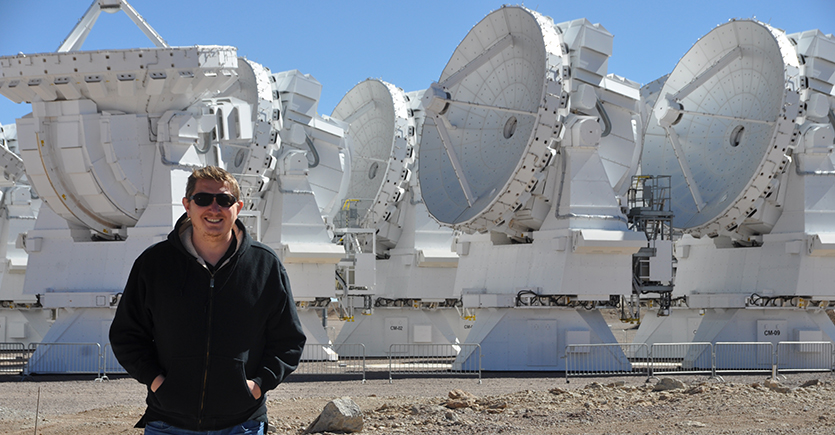
Umut Yildiz
Deep Space Communications Engineer
I was born in the massive city of Istanbul, Turkey. My father was the chief of police and, as a rule in Turkey, a policeman can’t stay in one city for more than five years. We moved to a few other cities like Karabuk, Zonguldak, and Canakkale until I finish my high school. Since then, I’ve moved a lot internationally, from London to Groningen, and from the Canary Islands to Leiden.
I feel like the passion was always there from a very early age. At primary school, I remember we had a thick science encyclopedia that I read cover to cover a few times. And growing up, we were living in the small city of Canakkale, Turkey, where our house was located just next to the beach. During the nights, I would sit at the beach and look at the sky, more and more fascinated by its mystery.
At the same time, I was making electronic circuits, fixing friends’ Walkmans (yes, there were Walkmans at the time!) etc., but it was after the movie “Contact” (1997), which helped me draw a real path to space research. When I saw Jodie Foster pressing a button and turning the New Mexico's Very Large Array radio telescope antennas, I shivered and said to myself, "One day, I am going to press that button and turn those radio telescopes as well.” I’ve since turned many telescopes many times during my career.
It was not an easy or fast path. In Turkey, there is no direct path to work professionally in space research. However, the closest I could find was the Astronomy and Space Sciences program at the University of Ankara. Following graduation, I moved to the U.K. to improve my English and a year later, I started at the University of Groningen in the Netherlands for a Master’s in astronomy. Groningen hosts part of the Dutch Space Agency (SRON), and that was where I first came into contact with the HIFI instrument, which is one of the Herschel Space Observatory’s three instruments. At that time, the engineers were building HIFI one level below my student office and I was always fascinated by the fact that it would go to space one day.
At the time, I never thought that this instrument would change my life. After completing my master’s, I was accepted to the Leiden Observatory PhD program in molecular astrophysics. There, I worked on data from Herschel's HIFI instrument and a number of ground-based radio/sub-millimeter telescopes. We discovered that there were massive water outflows in the forming stars but could not find oxygen molecules during the formation of a star. We’re hoping to find the answer to questions like, why do we have a lot of water and oxygen on Earth? Are they remainders from the formation of the Solar System? After the PhD, I came to JPL in September 2013 for a two-year postdoctoral position. Afterwards, I started at the Spectrum Engineering Group of Communication Architectures and Research Section to work on deep space telecommunications spectrum.
I was mostly self-motivated and turned to books in my early years, especially Carl Sagan’s “Contact.” My PhD advisers Ewine van Dishoeck and Lars Kristensen also really helped me grow professionally.
My passion for radio telescopes and big dishes brought me to the deep space telecommunications part of the space program. According to the definition of the International Telecommunication Union (ITU), a space probe located further than 2 million km away from the Earth, is called a deep space mission. Deep space missions use special frequency bands to communicate that are allocated and protected by the ITU internationally so that nobody else can use them. Our job is to allocate new frequencies to any new deep space missions that are to be launched by any country so that any possibility of interference is prevented and everybody can happily talk to their missions and not lose any data. We also protect our deep space antennas located in California, Madrid and Canberra from interference from any other nearby ground station antennas. Apart from that, I continue to do astrophysics research, where I am working to understand the formation of stars.
When the Herschel Space Observatory reached the L2 point in 2009 and started early performance verification observations. During the first year of my PhD, I was selected as one of the interns assigned to the HIFI Instrument Control Center in Groningen. The most amazing thing was to see and work with that very first Herschel data, where hundreds of people worked hard for more than 30 years to make this dream come true.
Since childhood, I have always wanted to work on challenging space projects and have even wanted to build a spaceship factory so that I could take people to Mars. I’ve noticed it’s not easy! So I’ll keep on working being a part of the deep space missions, helping answer old questions and ask new questions. That’s how science works and how humans advance.
Three things: Focus on your target, take risks, and never give up. Even during high school I knew that I would work in a space program one day. You only have one life and if you don’t have a clear goal, you will end up somewhere you might not like for quite a long time. Think big and have big dreams. You may not reach all of your dreams, but if you don’t dream big at all, it is guaranteed that you will not reach anything. Get out of your comfort zone and take risks. Then be flexible. As long as you have a clear final goal, you can alter your plan accordingly, but never give up.
I love spending my time inspiring young people to study STEM. I use social media, especially Twitter, to reach people and talk about astronomy, space and technology. I also do outreach for secondary, high school and university students about space research.
Planetary science is a global profession.

